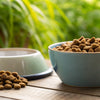Should You Give Dogs Wet Food? Understanding the Benefits and Drawbacks
- Houndsy
Table of Contents
- Introduction
- Understanding Wet Dog Food
- Analyzing Dry Dog Food
- Should You Give Dogs Wet Food?
- Enhancing the Feeding Experience with Houndsy
- Conclusion
- FAQ Section
Introduction
Did you know that over half of dog owners in the U.S. opt for dry dog food for their furry friends, despite the enticing aroma and sensory appeal of wet food? This statistic reflects a growing uncertainty among pet owners about the best dietary choice for their dogs. In today's world, where dog food options are abundant and diverse, understanding whether you should give dogs wet food has never been more important.
As devoted pet parents, we are constantly seeking ways to enhance the wellbeing of our canine companions. Nutrition plays a vital role in their overall health, and selecting the appropriate food can significantly impact their quality of life. In this blog post, we will dive into the essential aspects of wet dog food versus dry dog food, exploring the benefits, drawbacks, and nutritional considerations of each option. Additionally, we’ll reflect on how choosing the right food, combined with our innovative Houndsy Kibble Dispenser, can transform your pet's feeding experience into one that is convenient, consistent, and beautiful.
By the end of this post, you’ll gain valuable insights to help you make an informed decision about your dog's diet. So let’s embark on this journey together, keeping our beloved pets in mind!
Understanding Wet Dog Food
Wet dog food, often found in cans or pouches, is typically made from meat, grains, and a variety of added nutrients. The production process involves cooking the ingredients under high heat, which ensures they are safe and palatable. One of the standout features of wet dog food is its high moisture content, which can range from 70% to 80%, compared to the low moisture levels found in dry kibble.
Key Characteristics of Wet Dog Food
-
High Moisture Content: Wet dog food is rich in water, helping to improve hydration, which is particularly beneficial for dogs that may not drink enough water throughout the day.
-
Palatability: The aroma and texture of wet food often entice dogs, making it a great option for picky eaters or those with a diminished appetite.
-
Texture Variety: Available in numerous forms, such as pâté, chunks in gravy, or stews, wet food can cater to your dog’s personal preferences.
Nutritional Benefits of Wet Dog Food
-
Hydration: The significant moisture content helps maintain hydration levels, ideal for dogs susceptible to urinary or kidney issues.
-
Protein-Rich: Wet food typically contains higher levels of protein and fat when compared to dry kibble, supporting muscle health and energy in active dogs.
-
Easier to Chew: For senior dogs or those with dental issues, the softer consistency of wet food makes it easier to chew and swallow. This encourages consistent eating habits and can aid in recovery during illness.
Drawbacks of Wet Dog Food
Despite its many advantages, wet dog food does have some potential downsides:
-
Cost: Wet food is generally more expensive than dry kibble since it has a higher water content and shorter shelf life.
-
Messiness: Serving wet food can be messier than dry food, requiring additional cleanup after mealtime.
-
Shelf Life: Once opened, wet food must be refrigerated and consumed within a few days to prevent spoilage, leading to possible food waste.
-
Dental Health: Wet food does not contribute to dental health in the same way that dry kibble does—dogs require mechanical chewing action to help reduce tartar build-up.
Analyzing Dry Dog Food
The foundation of the dog food industry, dry kibble is convenient and widely available. Kibble is made by mixing and cooking ingredients to form a dough, which is then shaped and dried.
Key Characteristics of Dry Dog Food
-
Long Shelf Life: Kibble can remain fresh for several weeks after the bag is opened, making it easy to store and portion.
-
Lower Moisture Content: With moisture levels around 10%, dry food does not contribute as much to hydration.
-
Portion Control: Dry kibble allows for easier pre-measuring, making it suitable for dogs that graze or those with precise calorie requirements.
Nutritional Benefits of Dry Dog Food
-
Dental Health: The texture of dry kibble helps reduce plaque and tartar formation, promoting oral health and hygiene.
-
Convenience: Dry food is easy to dispense and can be left out without spoiling, which is beneficial for free-feeding dogs.
-
Cost-Effective: Typically, dry kibble is more affordable compared to wet food, making it a feasible option for dog owners on a budget.
Drawbacks of Dry Dog Food
While dry kibble has its strengths, it also has disadvantages:
-
Hydration Concerns: Dogs that primarily eat dry food may not consume enough water, leading to dehydration, especially in warmer climates.
-
Less Appealing: Many dogs find dry kibble less palatable than wet food, which can lead to decreased interest in meals.
-
Potential Ingredient Quality Concerns: Some dry dog foods can contain fillers that provide little nutritional value, so it’s crucial to select high-quality brands.
Should You Give Dogs Wet Food?
So, should you give dogs wet food? The answer largely depends on your dog’s individual needs, preferences, and any specific health conditions they may have.
Considering Your Dog's Unique Needs
-
Age: Puppies and senior dogs may benefit from the moist texture and enhanced flavor of wet food, while healthy adult dogs may thrive on either dry or wet food.
-
Health Conditions: Dogs with health issues, such as kidney disease, may greatly benefit from wet food's higher moisture content. Always consult your veterinarian before making dietary changes for health-related reasons.
-
Picky Eaters: If your dog is a finicky eater, incorporating wet food into their diet may entice them to eat more regularly.
Mixing Wet and Dry Food
Another option to consider is mixing wet and dry food. Combining the two can offer the best of both worlds, enhancing flavor and hydration while still allowing dental health benefits from dry kibble. However, it's essential to maintain portion control to prevent overfeeding.
-
Customization: Mixing can help you tailor your dog’s diet to their calorie needs while introducing variety and new flavors.
-
Transitioning: If you're switching to wet food, make sure to do so gradually to avoid gastrointestinal upset.
Making Informed Choices
As pet parents, we truly care about the choices we make for our dogs. It's essential to read labels, understand ingredient lists, and prioritize high-quality, nutritionally balanced options. When considering whether to transition to wet food or mix it with dry kibble, always consult your veterinarian for personalized recommendations tailored to your dog's specific requirements.
Enhancing the Feeding Experience with Houndsy
At Houndsy, we believe that pet feeding should be a beautiful and streamlined experience. Our flagship product, the Houndsy Kibble Dispenser, marries modern design with exceptional functionality. This innovative product not only dispenses the perfect portion every time but also serves as an elegant addition to your home decor.
Imagine effortlessly providing your dog with their preferred kibble or mixed meal without the hassle or mess of traditional food bowls. The Houndsy Kibble Dispenser features:
- A crank mechanism at a standing height, eliminating the need for bending over.
- Large storage capacity of 25–30 lbs, ensuring you’re always stocked up.
- A BPA-free liner to maintain the freshness of your dog’s food.
- An auto-locking mechanism that keeps curious pets and toddlers safe from accidental dispensing.
Let’s elevate the daily feeding ritual, ensuring that mealtime is as enjoyable for you as it is for your pup! Explore the Houndsy Kibble Dispenser here.
Conclusion
Ultimately, deciding whether to give dogs wet food requires careful consideration of their specific needs, preferences, and health conditions. While wet food offers many appealing benefits, including enhanced hydration and palatability, dry kibble remains an advantageous option for its convenience and dental health benefits.
As responsible pet owners, we must remain informed and proactive in our choices, ensuring we provide our furry companions with the best possible nutrition. Whether you choose wet food, dry kibble, or a harmonious mix of both, remember to embrace the role food plays in your dog’s happiness and wellbeing.
If you're ready to simplify and elevate your dog feeding experience, don’t forget to check out the Houndsy Kibble Dispenser and discover how it can transform your daily routine.
FAQ Section
Q: Is wet food better for my dog than dry food?
A: It depends on your dog’s individual needs. Wet food is higher in moisture and protein, which is beneficial for hydration and tasty for picky eaters. Dry food, however, can support dental health and is more convenient for storage. Mixing both could be a balanced approach.
Q: Can I feed my dog wet food exclusively?
A: Yes, many dogs thrive on a solely wet food diet as long as it’s nutritionally balanced. However, it's essential to monitor your dog's overall health and dental care.
Q: How can I switch my dog to wet food?
A: Transition gradually by mixing wet food with their current diet over several days. This helps avoid digestive upset and allows your dog to adapt to the new texture and flavor.
Q: What should I look for in a high-quality wet dog food?
A: Look for meat as the first ingredient, limited fillers, and a good balance of nutrients. Avoid foods with artificial additives and ensure that it meets the dietary needs of your dog’s age and health condition.
Q: Does wet food cause bad breath or dental issues?
A: While wet food doesn’t help with dental cleaning like dry kibble does, maintaining a regular dental care routine will help mitigate bad breath and oral health issues, regardless of the diet.












